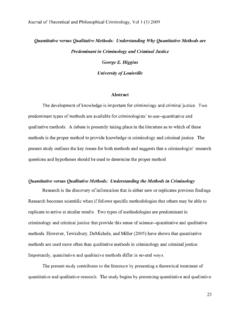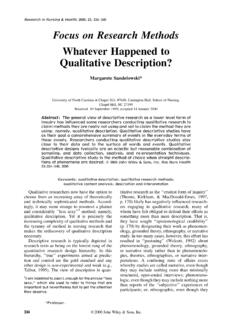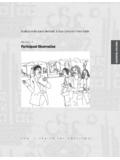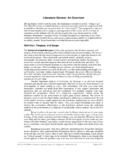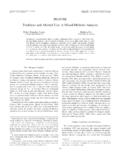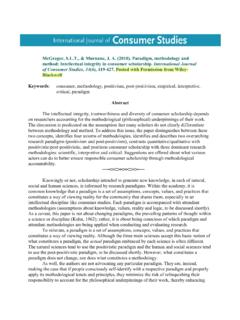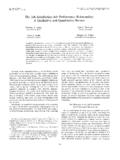Transcription of Quantitative Versus Qualitative Research, or Both?
1 Jones & Bartlett Learning, LLC. NOT FOR SALE OR DISTRIBUTION. Chapter 3. Quantitative Versus Qualitative research , or both ? Nursing research Worldviews Nursing research falls within the two broad worldviews, the positivist and the naturalistic paradigms. These two worldviews have opposing assumptions about reality and view of the world. For example, in regards to reality, the posi- tivist believes that a single reality exists that can be measured, whereas in the naturalistic paradigm, there are multiple realities that are continually chang- ing, which make it very difficult if not impossible to measure.
2 Other important opposing assumptions are listed in Table 3-1 . The two main types of research methods are Quantitative and Qualitative . Quantitative research aligns with the positivist paradigm, whereas Qualitative research most closely aligns itself with the naturalistic paradigm. Quantita- tive research is a formal, objective, deductive approach to problem solving. In contrast, Qualitative research is a more informal, subjective, inductive ap- proach to problem solving. More characteristics of each are compared in Table 3-2 . Even though Quantitative research has been considered the more rigor- ous of the two in the past, Qualitative research has gained more credibility in the science world recently.
3 In fact, both are appropriate methods for conduct- ing research , and each method can contribute greatly to the scientific body of knowledge. Selection of which method to use depends primarily on the re- search question(s) being asked. These questions flow from the research prob- lem and purpose statement. For example, testing a new fall prevention program within your hospital would require you to obtain a baseline fall rate before the program and then again after full implementation of the program. Statistically, you could com- pare rate of falls before the new program with the rate of falls after the new program.
4 Your unit of analysis would be numbers and would lend itself to a 35. 7004. Jones & Bartlett Learning, LLC. NOT FOR SALE OR DISTRIBUTION. 36 Chapter 3 Quantitative Versus Qualitative research , or both ? Table 3-1 Comparison of Major Assumptions of the Positivist and Naturalistic Paradigms Positivist paradigm Naturalistic paradigm There is a single reality that can be There are multiple realities that can be measured. studied only holistically and cannot be predicted or controlled although some level of understanding can be achieved. The researcher and the research The researcher and the research participant participant can remain independent cannot remain separate or independent.
5 Of one other and not influence one They interact and influence one another. another. Findings of research can be Findings cannot be generalized beyond the generalized from the study sample study sample. Knowledge gleaned from the to the larger target population. study is in the form of working hypotheses.. Cause and effect relationships can Cause and effect relationships cannot be be tested. tested since there are multiple realities that are continually changing, so it is impossible to distinguish causes from effects. research can be conducted research is subjective and value bound ( , objectively and value free.)
6 The researcher's own values). Table 3-2 Characteristics of Quantitative and Qualitative research Methodologies Quantitative research Qualitative research Considered a hard science Considered a soft science Objective Subjective Deductive reasoning used to synthesize Inductive reasoning used to synthesize data data Focus concise and narrow Focus complex and broad Tests theory Develops theory Basis of knowing cause and effect Basis of knowing meaning, discovery relationships Basic element of analysis numbers Basic element of analysis words, and statistical analyses narrative Single reality that can be measured and Multiple realities that are continually generalized changing with individual interpretation 7004.
7 Jones & Bartlett Learning, LLC. NOT FOR SALE OR DISTRIBUTION. Quantitative Designs 37. Table 3-3 Decisions Regarding Type of Design Goal is to research question Unit of analysis generalize Methodology What is the impact Paper and pencil test Yes Quantitative of a learner-centered resulting in hand washing hand washing program knowledge scores on a group of second graders? (Tousman, et al., 2007). What is the effect Blood pressure Yes Quantitative of crossing legs measurements before on blood pressure and after crossing legs measurement? (Keele- resulting in numbers Smith & Price-Daniel, 2001).
8 What are the Unstructured interviews No Qualitative experiences of black with black fathers fathers concerning (5 supportive and 5. support for their nonsupportive); results wives/partners during were left in narrative labor? (Sengane & Cur, form describing themes 2009) based on nursing for the whole person theory What is the experience Semi-structured No Qualitative of hope in women with interviews with women advanced ovarian with advanced ovarian cancer? (Reb, 2007) cancer (N=20). Identified codes and categories with narrative examples Quantitative design.
9 However, if you were interested in studying the impact of falls on patient's quality of life, you would most likely obtain that information through a personal interview. The unit of analysis would be words, and a quali- tative method would be the most appropriate approach to analyze this data. Table 3-3 depicts this strategy using sample research questions. Quantitative Designs Four main types of Quantitative designs are descriptive, correlational, quasi- experimental, and experimental. In general, choice of design is greatly influenced 7004.
10 Jones & Bartlett Learning, LLC. NOT FOR SALE OR DISTRIBUTION. 38 Chapter 3 Quantitative Versus Qualitative research , or both ? by the level of knowledge of the research problem. If the amount of descriptive level research is abundant over a particular problem area, then the next logical step is to do a correlational study to examine relationships between variables. If the problem area has been described and the relationships between variables tested, the next level of research would be quasi-experimental or experimental research . For example, a large amount of research exists on surgical site infec- tions, particularly descriptive, correlational, and quasi-experimental studies.











